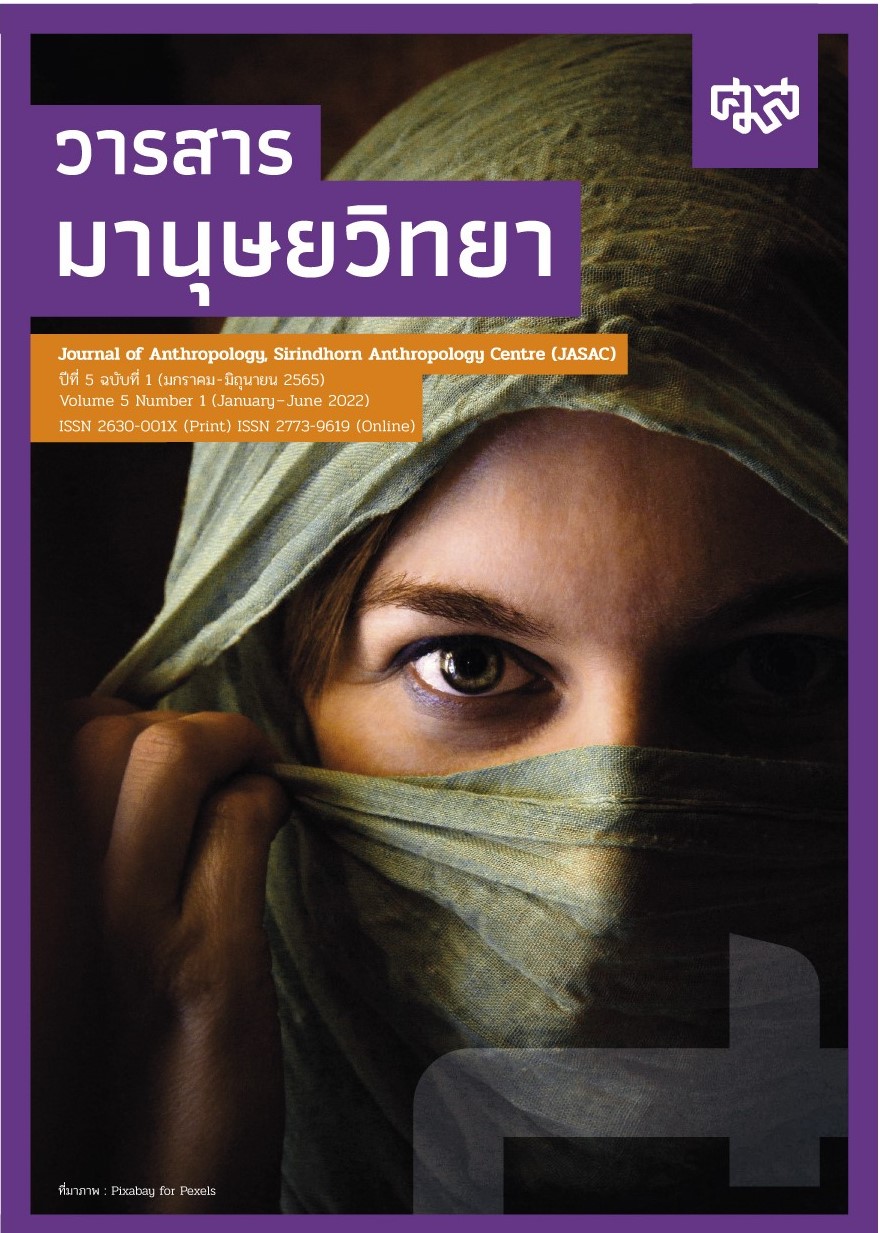“ฉันคือท้องฟ้าอันไร้ขอบเขต” ข้ามให้พ้นการยึดจักษุผัสสะเป็นใหญ่
Main Article Content
บทคัดย่อ
บทความวิจัยนี้มุ่งตอบคำถามว่า เราจะจัดวางความสัมพันธ์ระหว่าง
ตัวเรากับโลกในลักษณะที่ไม่ยึดติดอยู่กับวิธีคิดแบบจักษุผัสสะเป็นศูนย์กลางได้อย่างไร ในการตอบคำถามจะอาศัยตัวบทจำนวนหนึ่งมาช่วยในการอภิปราย โดยเฉพาะอย่างยิ่ง การแยกให้เห็นความแตกต่างระหว่างวิธีคิดแบบตะวันตกที่เน้นการใช้ดวงตาและการมองเห็นกับวิธีคิดแบบที่เน้นวิพากษ์ความคิดแบบตะวันตกซึ่งเน้นการใช้ผัสสะในภาพรวมทั้งหมด แม้ว่านักมานุษยวิทยา จำนวนหนึ่งจะวิพากษ์การยึดจักษุผัสสะ แต่พวกเขายังยึดติดอยู่กับการแยกและแบ่งผัสสะออกเป็นส่วน ๆ บ้างก็ให้ความสำคัญกับผัสสะแบบอื่น ๆ แทนที่ดวงตา แม้ในช่วงปลายศตวรรษที่ 20 จะมีการเสนอแนวคิดเรื่องการคร่อมข้ามผัสสะมาใช้เป็นทางออก แต่จากมุมมองเช่นนี้ การคร่อมข้ามผัสสะก็ยังยึดติดอยู่กับการมองแบบเป็นส่วน ๆ อยู่เช่นเดิม โดยไม่ได้นำไปสู่การแก้ปัญหา
ทว่าในความคิดของ Tim Ingold ซึ่งได้รับอิทธิพลจาก Maurice MerleauPonty กลับมองว่า ผัสสะของมนุษย์นั้นมีลักษณะเป็นองค์รวม ที่แยกออกเป็นส่วน ๆ ไม่ได้ รวมถึงงานทฤษฎีสถาปัตยกรรมในกระแสธารที่เรียกว่า “บรรยากาศศึกษา” นั้นก็ขยายความประเด็นดังกล่าวออกไป โดยชี้ว่า การรับรู้โลกของมนุษย์นั้นต้องอาศัยการดำรงอยู่ภายในโลกที่บรรยากาศกับตัวเราไม่ได้แยกออกจากกัน
Article Details

อนุญาตภายใต้เงื่อนไข Creative Commons Attribution-NonCommercial-NoDerivatives 4.0 International License.
ลิขสิทธิ์@ของวารสารมานุษยวิทยา
ศูนย์มานุษยวิทยาสิรินธร (องค์การมหาชน), กรุงเทพฯ, ประเทศไทย
ข้อมูลเพิ่มเติม:
https://creativecommons.org/licenses/by-nc-nd/4.0/
เอกสารอ้างอิง
Abram, D. 1997. The Spell of the Sensuous: Perception and Language in More-Than-Human World. New York: Vintage Books.
Abram, D. 2018. “The Forgetting and Remembering of the Air.” in Judha
Su and Mi You eds., Storytellers Before the Dawn: An Anthology.
(pp. 133-196). Bangkok: Ghost Foundation and OPEN FIELD.
Balibar, E. 2020. Spinoza, The Transindividual. Edinburgh: Edinburgh University Press.
Blanchot, M. 1995. The Writing of the Disaster. Lincoln and London: University of Nebraska Press.
Böhme, G. 2014. “Urban Atmosphere: Charting New Directions for Architecture and Urban Planning.” in Christian Borch ed., Architectural Atmospheres: On Experience and the Politics of Architecture. (pp. 42-59). Basel: Birkhauser.
Böhme, G. 2017. Atmospheric Architectures: The Aesthetics of Felt Spaces. London and New York: Bloomsbury.
Borch, C. ed. 2014. Architectural Atmospheres: On Experience and the
Politics of Architecture. Basel: Birkhauser.
Butler, S. and Purves, A. eds. 2013. Synaesthesia and the Ancient Senses.
Durham: Acumen.
Cytowic, R. E. 2002. Synesthesia: A Union of the Senses. Cambridge and London: The MIT Press.
Derrida, J. 1994. Of Grammatology. Delhi: Motilal Banarsidass.
Descola, P. 2013. Beyond Nature and Culture. Chicago and London: University of Chicago Press.
Griffero, T. 2017. Quasi-Things: The Paradigm of Atmospheres. New York: SUNY Press.
Haraway, D. 2016. “The Companion Species Manifesto: Dogs, People,
and Significant Otherness.” in Manifestly Haraway. (pp. 91-198). Minneapolis and London: University of Minnesota Press.
Ingold, T. 2000. “Stop, look and listen!: Vision, hearing and human movement.” In The Perception of Environment: Essays on Livelihood, Dwelling and Skill. (pp. 243-287). New York and London: Routledge.
Ingold, T. 2011. “Against space: place, movement and knowledge.” in
Being Alive: Essays on Movement, Knowledge and Description. (pp. 145-155). London and New York: Routledge.
Ingold, T. 2011. “Landscape or Weather-World?.” in Being Alive: Essays
on Movement, Knowledge and Description. pp. 126-135. London and New York: Routledge.
Jullien, F. 2012. The Great Image Has No Form, or On the Nonobject Through Painting. Chicago and London: The University of Chicago Press.
Jullien, F. 2018. Living Off Landscape: or the Unthought-of in Reason. London and New York: Rowman & Littlefield International.
Jullien, F. 2020. From Being to Living: a Euro-Chinese Lexicon of Thought.
London and Los Angeles: SAGE.
Lloyd, G. E. R. 2007. Cognitive Variations: Reflections on the Unity & Diversity of the Human Mind. Oxford and New York: Oxford University Press.
Lusseyran, J. 2016. Against the Pollution of the I: On the Gifts of Blindness, the Power of Poetry, and the Urgency of Awareness. Novato, California: New York World Library.
Mathews, F. 2011. “Toward a Deeper Philosophy of Biomimicry.” Organi-
zation & Environment, 24(4), 364-387.
McLuhan, E. 2015. The Sensus Communis, Synesthesia, and the Soul: An Odyssey. Toronto and New York: BPS Books.
Moore, J. W. 2015. Capitalism in the Web of Life: Ecology and Accumulation of Capital. London and New York: Verso.
Ong, W. J. 2002. Orality and Literacy: The Technologizing of the World.
London and New York: Routledge.
Pallasmaa, J. 2012. The Eye of the Skin: Architecture and the Senses. West Sussex: John Wiley & Sons.
Rogowska, A. M. 2015. Synaesthesia and Individual Differences. Cambridge:
Cambridge University Press.
Sloterdijk, P. 1987. Critique of Cynical Reason. Minneapolis and London: University of Minnesota Press.
van Campen, C. 2007. The Hidden Sense: Synesthesia in Art and Science.
Cambridge and London: The MIT Press.
Viveiros de Castro, E. 2015. The Relative Native: Essays on Indigenous Conceptual Worlds. Chicago: HAU Books.
Zumthor, P. 2006. Atmospheres. Basel: Birkhauser


